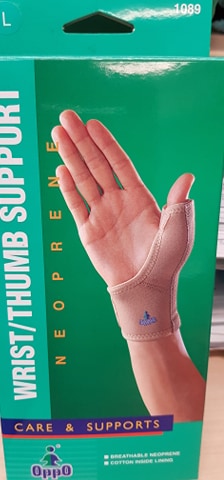DeQuervain’s Tenosynovitis typically presents with local tenderness and swelling over the thumb side of your wrist.
What are the causes of DeQuervain’s Tenosynovitis?
- DQT is caused by the repetitive and excessive loading of the 2 thumb tendons (abductor pollicus longus & extensor pollicus longus) as they slide under a band of connective tissue at the wrist (the extensor retinaculum).
- It’s linked to a degenerative mechanism where there is thickening of the tendon sheaths and retinaculum but some studies have also shown inflammatory cells which may be the reason symptoms can be reduced with anti-inflammatory treatments-either injections or medication.
- This condition is more prevalent in pregnancy(during and post) due to the combination of fluid retention, hormonal changes & the mechanical irritation of repetitive lifting a newborn. (9)
- Women aged 30-50 have a higher incidence (1,2)
What is the treatment for DeQuervain’s Tenosynovitis?
DQT responds well to conservative treatment including
- rest/ice
- NSAID’s (medication or injection)
- Laser (3,4,5,6)
- Therapeutic ultrasound (8)
- Splinting (7,8)
- Taping
- Stretching
- Acupuncture
- Advice and education

These treatments can be used in combination with good effect.
While this advice is based on most recent research, if you are experiencing symptoms please seek professional assessment and personalised advice for an individualised management for your case.
We’d love to help – call 5535 5218 to make an appointment.
References
1. Mardani-Kivi M, Mobarakeh MK, Bahrami F, Hashemi-Motlagh K, Saheb-Ekhitari K, Akhoondzadeh N. (2014) Corticosteroid Injection with or without Thumb Spica cast for de Quervain’s tenosynovitis. Journal of hand Surgery. 39:1, 37-41.
2. Wolf JM, Sturdivant RX, Owens BD. (2009) Incidence of de Quervain’s tenosynovitis in a young, active population. J Hand Surg Am. 34(1);112-5
3. Tumilty S, Munn J, McDonough, Hurley DA, Basford JR, Baxter D. (2010). Low Level Laser Treatment of Tendinopathy: A Systematic Review with Meta-Analysis. Photomedicine and Laser Surgery. 28:1
4. Renu Sharma, Anjeti Thukral, Sudhir Kumar, SK Bhargava. (2002) Effect of Low Level Lasers in de Quervain’s Tenosynovitis. Prospective study with ultrasonographic assessment. Physiotherapy, 88:12, 730-734.
5. Bjordal JM, Couppe CW, Ljunggren AE (2001) Low Level Laser Therapy of Tendinopathy. Evidence of A Dose-Response Pattern. Physical Therapy Reviews. June 2001.
6. Sharma R, Thukral A, Kumar S, Bhargava S. Effect of low level lasers in de Quervain’s tenosynovitis. Physiotherapy. 2002;88(12):730e734.
7. Goel R, Abzug JM. (2015) de Quervain’s tenosynovitis: a review of the rehabilitative options. Hand (N.Y). 10(1);1-5.
8. Awan WA, Babur MN, Masood T. (2017) Effectiveness of therapeutic ultrasound with or without Thumb Spica in the management of de Quervain’s disease. Journal of back and Musculoskeletal Rehabilitation. 30(4): 691-697
9. Mak Jenson. (2018) De Quervain’s Tenosynovitis: Effective Diagnosis and Evidence-Based Treatment. 10.5772/intechopen. 82029







